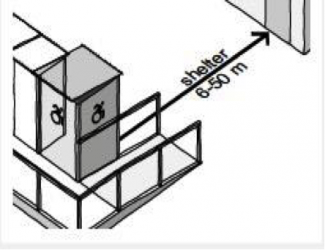Washroom
At least 10% of washrooms should be accessible for persons with disabilities, clearly signposted and located within 50m of individual shelters in a camp/settlement, or within 15m of an individual shelter:
- Make sure that the entrance is wide enough for a wheelchair user to enter (at least 90 cm) and ramps are provided where necessary. Door handles and proper locking is available and accessible;
- Signage has to be clear and accessible to persons with visual impairment;
- Make sure that there is sufficient space inside for a wheelchair user to move around (minimum 150 cm turning radius) and to transfer from the wheelchair to the washing facility (bench, bathing seat, shower).


Other elements that will help for a proper design of washrooms:
- Ensure proper lightning and safety: holes for ventilation and lighting should be placed high enough to avoid view from outside;
- Locks should be adapted to be easy to grab;
- Make adaptations to latrines and showers including special equipment as for example installing washing benches for easy cleaning, handrails as support for proper balance;
- Pay attention to the floor, for safety and cleanliness;
- Provide accessible bathing equipment (consult with persons with disabilities or disability specific organisations for advise): bench, seats, utensils, etc.
There is no one plan that is to be taken as a model, planners must take into account the environment, contextual elements of the country, hygiene habits and experiences of the users to make specific plans to build and adapt washrooms. However, see below several examples of designs for inspiration.


Bathing facilities should ensure maximum privacy and dignity; women and girls with disabilities should be consulted about their personal hygiene practices, specific needs and priorities. Single sex focus group discussions with same-sex facilitators would ease the process and lead to good acceptance.